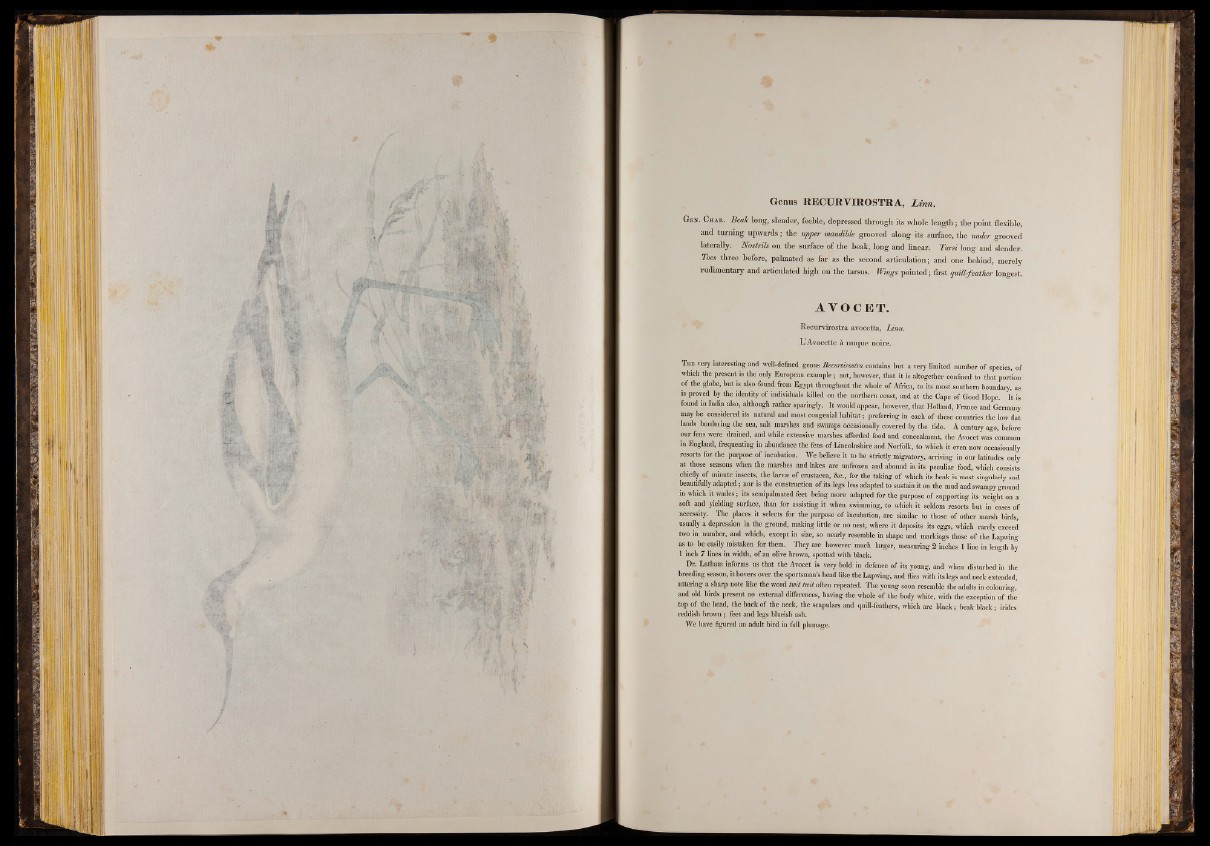
Genus RECURVIROSTRA, Linn.
Gen. Chab. Beak long, slender, feeble, depressed through its whole length; the point flexible,
and turning upwards ; the upper mandible grooved along its surface, the under grooved
laterally. Nostrils on the surface of the beak, long and linear. Tarsi long and slender.
Toes three before, palmated as far as the second articulation; and one behind, merely
rudimentary and articulated high on the tarsus. Wings pointed; first quill-feather longest.
A Y O CET.
Recurvirostra avocetta, Linn.
L’Avocette à nuque noire.
The very interesting and well-defined genus Recurvirostra contains but a very limited number o f species, of
which the present is the only European example ; not, however, that it is altogether confined to that portion
o f the glohe, hut is also found from Egypt throughout the whole o f Africa, to its most southern boundary, as
Is proved by the identity o f individuals killed on the northern coast, and at the Cape o f Good Hope. It is
found in India also, although rather sparingly. It would appear, however, that Holland, France and Germany
may he considered its natural and most congenial habitat ; preferring in each o f these countries the low fiat
lands bordering the sea, salt marshes and swamps occasionally covered by the tide. A century ago, before
our fens were drained, and while extensive marshes afforded food and concealment, the Avocet was common
in England, frequenting in abundance the fens o f Lincolnshire and Norfolk, to which it even now occasionally
resorts for the purpose o f incubation. We believe it to be strictly migratory, arriving in our latitudes only
at those seasons when the marshes and lakes are unfrozen and abound in its peculiar food, which consists
chiefly o f minute insects, the larvae o f Crustacea, &c., for the taking o f which its beak is most singularly and
beautifully adapted ; nor is the construction o f ils legs less adapted to sustain it on the mud and swampy ground
in which it wades ; its semipabnated feet being more adapted for the purpose o f supporting its weight on a
soft and yielding surface, than for assisting it when swimming, to which it seldom resorts but in cases of
necessity. The places it selects for the purpose o f incubation, are similar to those o f other marsh birds,
usually a depression in the ground, making little or no nest, where it deposits its eggs, which rarely exceed
two in number, and which, except in size, so nearly resemble in shape and markings those o f the Lapwing
as to be easily mistaken for them. They are however much larger, measuring 2 inches 1 line in length by
1 inch 7 lines in width, o f an olive brown, spotted with black.
Dr. Latham informs ns that the Avocet is very bold in defence o f its young, and when disturbed in the
breeding season, it hovers over the sportsman’s head like the Lapwing, and flies with its legs and neck extended,
uttering a sharp note like the word twit twit often repeated. The young soon resemble the adults in colouring,
and old birds present no external differences, having the whole o f the body white, with the exception o f thé
top o f the head, the back o f the neck, the scapulars and quill-feathers, which are black ; beak black ; irides
reddish brown ; feet and legs blueish ash.
We have figured an adult bird in full plumage.